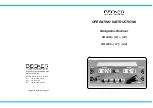
89000046-014
KSN 780/8XX/900 AeroNav AML STC Installation Manual for Helicopters
Rev 0
Page-3-2
© Honeywell International Inc. Do not copy without express permission of Honeywell.
Doubler Fabrication:
•
Doubler material is to be 2024-T3 clad aluminum per AMS QQ-A-
250/5
•
Form the doubler to match the fuselage curvature
•
Etch, alodine, and prime the doubler per the guidance provided in
AC43.13-1B
•
Drill holes and install rivets per AC43.13-1B
o
It is acceptable to slightly vary the rivet and row spacing
to accommodate existing frames and stringers provided
2D edge distance and 4D minimum rivet spacing is
maintained and no rivet is installed within 0.75” of the
antenna mounting holes
o
Rivet type is dependent on the type of rivets in the
adjacent fuselage structure. If the adjacent rivets in the
structure around the bay selected for the doubler
installation are protruding head type, install MS20470AD
rivets in the outer row of the doubler. If the adjacent
rivets are countersunk or dimpled, install either
MS20426AD or NAS1097AD rivets per the table below.
Reference Table 120 for rivet type and doubler thickness
appropriate for the aircraft's skin thickness.
Fuselage Thickness
Doubler Thickness
Doubler Drawing
0.016-0.025"
0.020"
See Figure C - 8 and C-9in
Appendix C.
0.032-0.050
0.032"
Table 33 Doubler Thickness
3.3.1 GPS Antenna Location
The following recommendations should be followed when choosing an installation location for the
GPS antenna. Prior to installing the GPS antenna, it is recommended to temporarily mount the GPS
antenna in the desired location and functional ground test the GPS system.
•
The antenna must be mounted on the exterior upper fuselage of the
aircraft
•
The GPS antenna should be mounted more than 2 feet from any
transmitting antenna.
•
The GPS antenna should be mounted in a location that minimizes the
effects of shadowing by the aircraft structure.
•
The GPS antenna should be installed more than 6 inches from any other
antenna, including another GPS antenna.
•
The GPS antenna should be installed in a location that allows the antenna
to be level in normal cruise flight.
•
For multiple GPS installations, the antennas should not be mounted in a
straight line from front to rear of the aircraft along the longitudinal axis on
the aircraft to prevent simultaneous antenna damage from lightning
strikes.
•
Antennas should be installed 3” or more from the windshield.





































